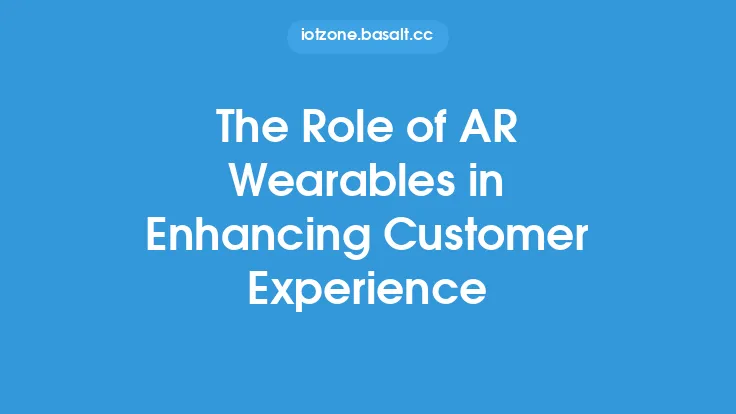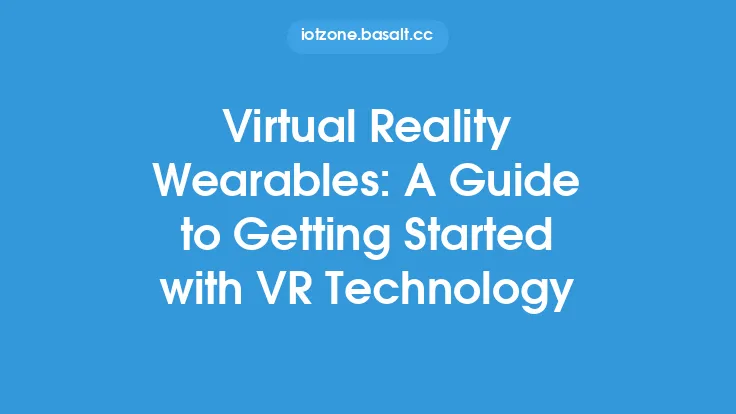The concept of virtual reality (VR) wearables has been around for several decades, but it's only in recent years that the technology has advanced to the point where it's become a viable and accessible tool for enhancing human experience. At its core, VR wearables are devices that allow users to immerse themselves in a completely digital environment, shutting out the physical world and replacing it with a virtual one. This can be achieved through a variety of devices, including head-mounted displays (HMDs), augmented reality (AR) glasses, and even VR-enabled contact lenses.
What are Virtual Reality Wearables?
Virtual reality wearables are devices that are designed to be worn on the body, typically on the head or face, and provide a virtual environment that can be experienced through a combination of visual, auditory, and sometimes even tactile feedback. These devices use a range of technologies, including displays, sensors, and software, to create an immersive experience that can simulate real-world environments, fantastical worlds, or even abstract concepts. VR wearables can be used for a wide range of applications, from gaming and entertainment to education, therapy, and even social interaction.
Key Components of Virtual Reality Wearables
There are several key components that make up a virtual reality wearable device. These include:
- Display: The display is the component that shows the virtual environment to the user. This can be a traditional LCD or OLED screen, or even a more advanced technology such as a micro-LED or electroactive polymer display.
- Sensors: Sensors are used to track the user's movements and provide feedback to the device. These can include accelerometers, gyroscopes, and magnetometers, which work together to provide a precise sense of the user's position and orientation in space.
- Software: The software is the component that brings the virtual environment to life. This can include operating systems, applications, and content, such as games, videos, and interactive experiences.
- Controllers: Controllers are used to interact with the virtual environment. These can include handheld devices, gesture recognition systems, or even brain-computer interfaces.
How Virtual Reality Wearables Work
Virtual reality wearables work by using a combination of hardware and software to create an immersive experience. The process typically starts with the user putting on the device, which is then calibrated to their specific needs and preferences. The device uses its sensors to track the user's movements, and this information is used to render the virtual environment in real-time. The user can then interact with the virtual environment using controllers or other input devices, and the device provides feedback through a combination of visual, auditory, and tactile cues.
Types of Virtual Reality Wearables
There are several types of virtual reality wearables, each with its own unique characteristics and applications. These include:
- Head-mounted displays (HMDs): HMDs are the most common type of VR wearable, and are characterized by a headset that is worn on the head. Examples of HMDs include the Oculus Rift and the HTC Vive.
- Augmented reality (AR) glasses: AR glasses are a type of VR wearable that overlays digital information onto the real world. Examples of AR glasses include Google Glass and Microsoft HoloLens.
- Virtual reality masks: Virtual reality masks are a type of VR wearable that provides a more immersive experience than HMDs or AR glasses. Examples of virtual reality masks include the Oculus Quest and the Valve Index.
Advantages and Limitations of Virtual Reality Wearables
Virtual reality wearables have several advantages, including:
- Immersive experience: VR wearables provide an immersive experience that can simulate real-world environments, fantastical worlds, or even abstract concepts.
- Increased engagement: VR wearables can increase engagement and interaction with digital content, making it more enjoyable and effective.
- Cost-effective: VR wearables can be more cost-effective than traditional methods of experiencing virtual environments, such as large screens or projection systems.
However, VR wearables also have several limitations, including:
- Limited field of view: VR wearables can have a limited field of view, which can make it difficult to see the virtual environment in its entirety.
- Latency: VR wearables can experience latency, which can cause delays between the user's movements and the response of the virtual environment.
- Eye strain: VR wearables can cause eye strain, which can be uncomfortable and even painful for some users.
Technical Requirements of Virtual Reality Wearables
Virtual reality wearables require several technical components to function, including:
- Processing power: VR wearables require significant processing power to render the virtual environment in real-time.
- Memory: VR wearables require sufficient memory to store the virtual environment and any associated data.
- Display resolution: VR wearables require a high display resolution to provide a clear and detailed virtual environment.
- Sensor accuracy: VR wearables require accurate sensors to track the user's movements and provide feedback to the device.
Conclusion
Virtual reality wearables are a rapidly evolving technology that has the potential to enhance human experience in a wide range of applications. From gaming and entertainment to education, therapy, and social interaction, VR wearables can provide an immersive and engaging experience that can simulate real-world environments, fantastical worlds, or even abstract concepts. While there are several advantages to VR wearables, there are also limitations, including limited field of view, latency, and eye strain. As the technology continues to advance, we can expect to see even more sophisticated and effective VR wearables that can provide a seamless and immersive experience for users.





